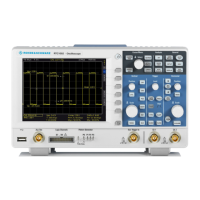Serial Bus Analysis
R&S
®
RTC1000
120User Manual 1335.7352.02 ─ 02
11 Serial Bus Analysis
To trigger and decode serial buses on the digital channels and on the analog inputs,
the following options are available:
●
R&S RTC-K1: I
2
C and SPI buses
●
R&S RTC-K2: UART/RS-232 buses
●
R&S RTC-K3: CAN and LIN buses
The serial bus analysis is performed with 1/8 of the sampling rate.
The usage of digital channels requires the logic probe R&S RT-ZL03 and option
R&S RTC-B1.
In the "BUS" menu, you find also the settings for parallel buses. Parallel buses are
dedicated for analysis of logic channels and described in Chapter 9, "Mixed Signal
Operation (Option R&S RTC-B1)", on page 107.
The analysis of parallel and serial data consists of the following three basic steps:
●
Protocol configuration (bus type / protocol-specific settings)
●
Decoding (Display of decoded data / zoom / bus table)
●
Trigger (Start / stop / serial pattern)
11.1 Bus Configuration
Before you can adjust the settings for the trigger and decoding functions, you must
define a bus. Two buses, B1 and B2, can be defined.
Before you configure the bus, set the correct logic level (threshold).
●
For analog channels, see "THRESHOLD menu" on page 36.
●
For digital channels, see "To set the threshold for logic states" on page 108. The
default value is 500 mV.
To define a bus
1. Press the BUS key in the Vertical section until it lights up in white.
2. In the short menu, press the softkey "B1" or "B2" until a menu opens.
Alternatively, press the MENU button in the Vertical section and press the top soft-
key to define the bus.
3. Press "BUS TYPE" and use the UNIVERSAL knob to select one of the following
bus types:
● "PARALLEL" and "PARALLEL CLOCKED": analysis of logic channels, see
Chapter 9.5.1, "Parallel / Parallel Clocked Bus", on page 111.
Bus Configuration

